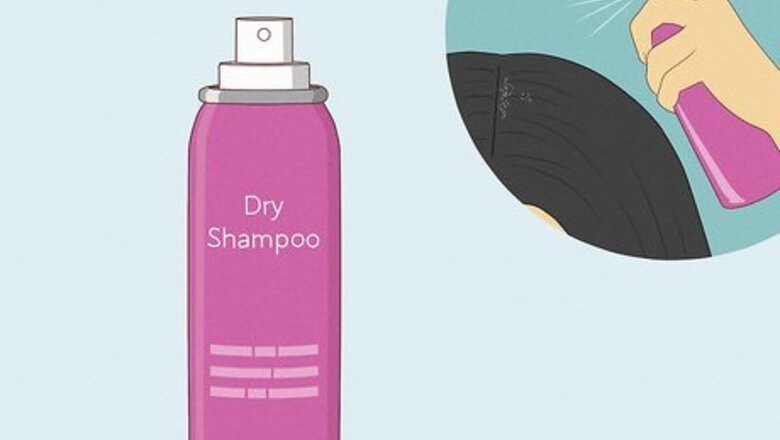
views
- For a 5-minute dandruff fix, spray your hair with dry shampoo and comb out the flakes. Part and comb your hair to hide the worst spots or put on a scarf or hat.
- Combine 1 US tbsp (15 mL) of coconut oil, 1 tsp (4.9 mL) of lemon juice, and 2-3 drops of tea tree oil. Massage it into your scalp, leave it in overnight, then wash it out.
- Use a medicated dandruff shampoo like Head & Shoulders, Selsun Blue, Neutrogena T/Sal 2-3 times per week.
Hiding Dandruff without Washing
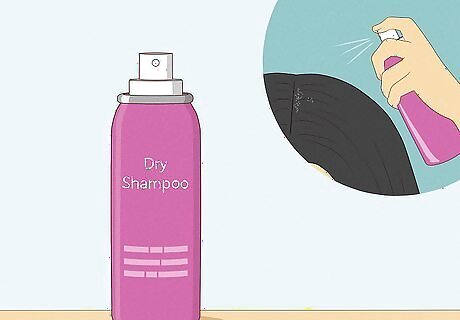
Spray your hair with dry shampoo to comb out any large flakes. Dry shampoo can reduce oil or grease and make your hair look fresh and clean. Spray dry hair shampoo on the parts of your hair with the most dandruff. Hold the canister at least 6 inches (15.24 cm) away from your scalp as you spray. Massage your scalp down to the roots to evenly distribute the product, then use a comb to brush out flakes. Rinse your comb after each stroke. Although dry shampoo can help hide dandruff in a pinch, try to only use it as a temporary fix. If it’s used regularly it can irritate your scalp and cause even more scaling and flaking.
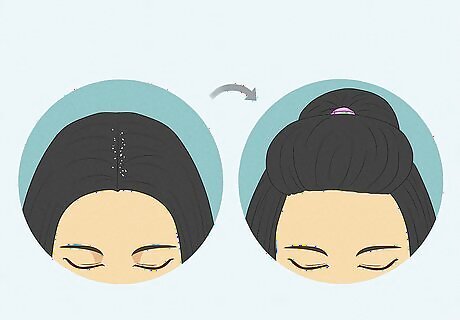
Hide the worst areas with a different hairstyle. While covering up your dandruff won’t solve the issue, it can be an easy visual fix. If your hair is shorter, apply a hairstyling product like a gel and tousle your hair with your fingers to fluff it up and make any dandruff less noticeable. If you have longer hair, here are some easy styles to quickly cover up flaking: Put your hair into braids, whether you want them loose or tight. Braids can also help prevent dandruff from falling on your shoulders during the day. Use bobby pins and a ponytail holder to tie your hair into a top knot bun. Tying your hair up on your head might help stop flakes from falling from your head. Throw your hair into a simple half-ponytail using just a hair tie. If your dandruff is concentrated more on the top of your head, a half-pony can help hide it. Wearing a cap, hat, or scarf on your head can also cover dandruff and prevent it from falling onto your shoulders.
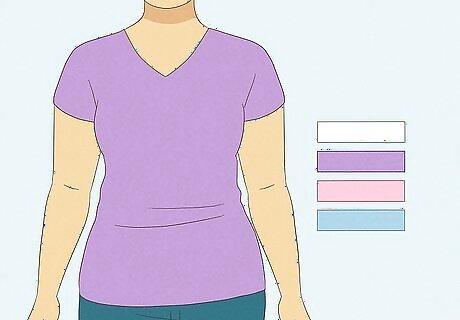
Wear an outfit with light colors. White and yellow skin flakes might be noticed more on darker colors, like black or navy clothing. Instead, try to wear white or pastel-colored shirts to help conceal dandruff. You can also wear an off-the-shoulder shirt since flakes usually aren’t visible when they’re directly on skin. You can also wear textured or pattered clothing to help hide dandruff.
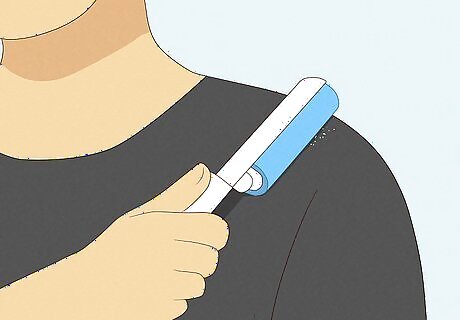
Use a lint roller to remove flakes on your clothes. Before you head outside, grab a pocket-sized lint roller to take with you. Whenever you notice dandruff on your clothes, slip away to the bathroom and use the lint roller to pick up any stray flaking. You can also carry a small comb with you to gently brush out any noticeable flakes in your hair.
Quick Home Remedies
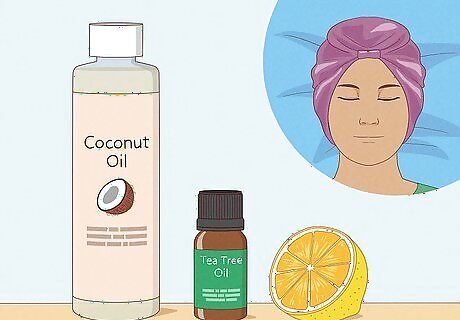
Apply a mixture of tea tree oil, lemon, and coconut oil to your scalp. Mix roughly 1 US tbsp (15 mL) of coconut oil, 1 tsp (4.9 mL) of lemon juice, and a couple of drops of tea tree oil together. Use your fingers to gently massage the mixture into your scalp and roots. Wrap your hair in a plastic, cotton, or silk hair wrap before going to bed. In the morning, wash off the mixture with a normal shampoo. Use this remedy 2 to 3 times a week. If you don’t have tea tree oil on hand, you can swap it out for lime, mangosteen, or rosemary oil. You can also dilute lemon juice or a lemon essential oil with water to cleanse your hair of excess oil. Studies suggest that tea tree oil can fight off Malazessia, a fungus that might cause seborrheic dermatitis and dandruff. Coconut oil and lemon might also have antimicrobial properties that fight off flaking.
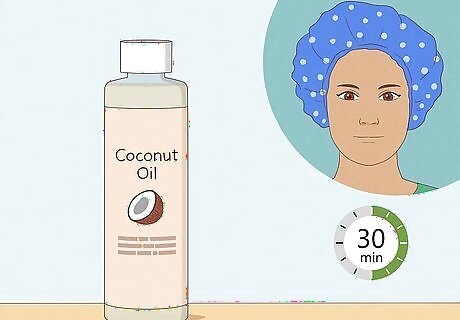
Massage coconut oil into your scalp and roots. One study showed that coconut oil can help hydrate the skin, prevent dryness, and improve the scalp’s microbiome. Apply 1–2 teaspoons (4.9–9.9 mL) of coconut oil to your hands and massage it into your scalp. Cover your head with a shower cap or wrap for about 30 minutes. After it sets, use a normal shampoo and rinse your hair well. Use this deep-conditioning treatment 2 to 3 times a week. If your coconut oil is in a solid form, melt it in a small bowl in the microwave or over the stove in a pan. Wait at least 10 minutes for the oil to cool so it won’t burn your fingers or scalp. If you don’t have coconut oil available, you can also use olive oil. Rub several drops of oil into your hair, cover your hair with a cap or wrap, and leave it in overnight. In the morning, shampoo and rinse your hair thoroughly.
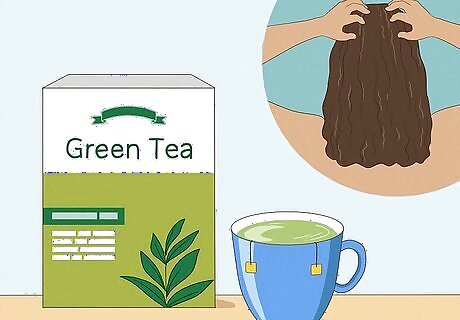
Make a hair mask with green tea. Green tea contains anti-inflammatory catechins that may help soothe an irritated scalp and reduce dandruff. Brew a pot of green tea using 2 tea bags in 2 cups (8.3 oz) of hot water for 2-3 minutes. Let it cool completely, then strain out the tea. Massage the tea water into your scalp and roots after shampooing. Leave it in for a few minutes, then rinse with cool water to lock in the antioxidants and apply conditioner. Repeat this remedy 2 to 3 times a week. You can also combine matcha with coconut or olive oil to help further reduce dandruff symptoms. Mix 1 tablespoon (15 mL) of oil with 2 teaspoons (11.38 g) of matcha green tea powder, apply it to your scalp, leave it in for 30 minutes, then wash your hair with shampoo.
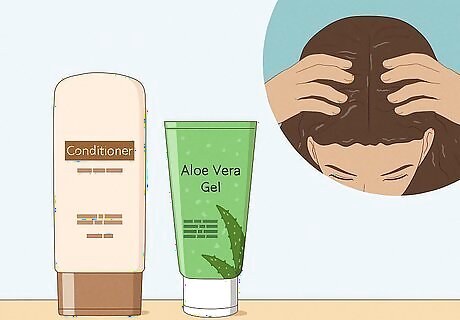
Add aloe vera to your conditioning routine. Aloe vera may be able to help treat skin conditions, reduce inflammation, and protect against dandruff. Mix 1 tablespoon (15 mL) of aloe into your favorite conditioner and massage a little bit into your roots. Rinse as normal and repeat once a week or as needed.
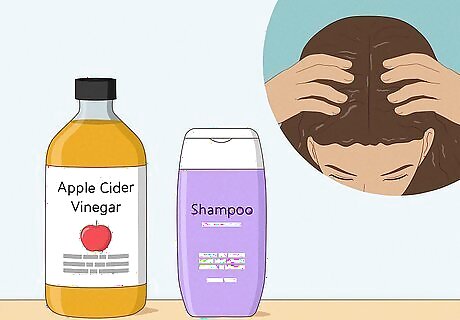
Add apple cider vinegar to your shampoo. Apple cider vinegar is said to help balance your skin’s pH, reduce produce or oil buildup, and relieve itching and dandruff. Add 1–2 tablespoons (15–30 mL) to your shampoo and massage it into your scalp, then rinse as normal. Or, combine 1–2 tablespoons (15–30 mL) of ACV with a few drops of essential oils and warm water and spray it directly onto your hair with a spray bottle. Repeat this process once a week. Apple cider vinegar is incredibly acidic and can irritate or damage your skin if not diluted, so always mix a small amount with shampoo or warm water.
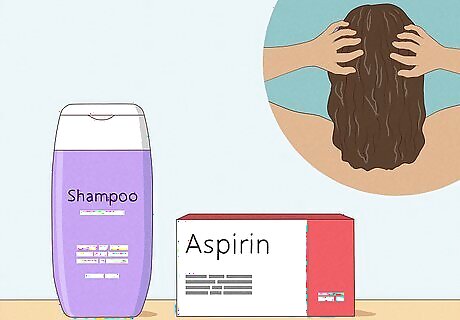
Mix two crushed aspirin tablets into your shampoo. Aspirin contains salicylic acid, which is found in many anti-dandruff shampoos and can help get rid of scaly skin and loosen flakes on your scalp. Use a spoon or butter knife to crush two aspirin tablets into a fine powder and mix it into your shampoo. Wash and rinse your hair as normal, and repeat this process as needed to reduce flaking.
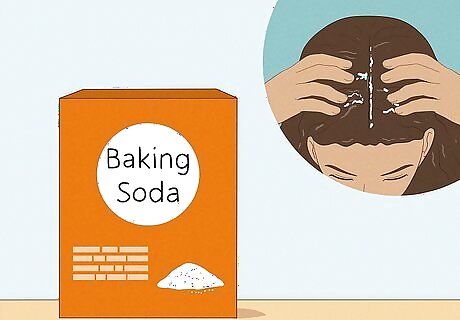
Apply baking soda directly to your wet hair while you’re in the shower. Baking soda is a convenient dandruff remedy that has antifungal and exfoliating properties that may help reduce flaking. Before shampooing, take 1 to 2 tablespoons (14.175 to 28.3 g) of baking soda and massage it into your scalp. Then wash and condition your hair as normal. Repeat this method once a week.
Using Dandruff Shampoo
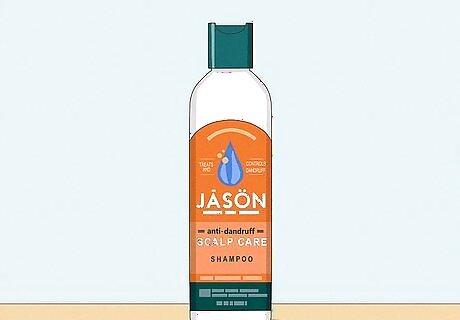
Choose an anti-dandruff shampoo that helps control itching and flaking. Many dandruff shampoos are classified based on the ingredients they contain. If you have small flakes that don’t go away after regular cleansing with a gentle shampoo, look for a mild dandruff shampoo that contains salicylic acid or fluocinolone. EXPERT TIP Yan Kandkhorov Yan Kandkhorov Hair Stylist Yan Kandkhorov is a Hair Stylist and Owner of K&S Salon, a hair salon based in New York City's Meatpacking District. Yan has over 20 years of experience in the hair industry, is best known for paving the way for iconic hair trends in the industry, and has operated his salon since 2017. His hair salon has been voted one of the Best Hair Salons in New York City in 2019 by Expertise. Yan and K&S Salon has collaborated with leading fashion magazines and celebrities such as Marie Clair USA, Lucy Magazine, and Resident Magazine. Yan Kandkhorov Yan Kandkhorov Hair Stylist Try to find a sulfate-free anti-dandruff shampoo for a gentle option. A lot of anti-dandruff shampoos contain sulfates, which are harsh cleansers. However, you can find some sulfate-free shampoos that contain chemicals like salicylic acid to treat dandruff, like R+Co Crown. Salicylic acid shampoos: Neutrogena T/Sal, Briogeo Scalp Revival, Jason Dandruff Relief Treatment Shampoo Fluocinolone shampoos (prescription required): Capex, Derma-Smoothe/FS Shampoos with coal tar may slow down how quickly skin cells on your scalp die and flake off. However, many people advise against using it because it can change the color of your hair, make your skin more sensitive to sunlight, and produce allergic or adverse reactions.
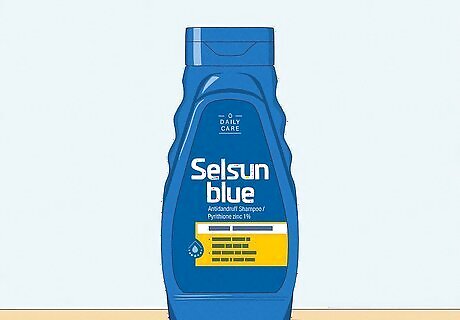
Choose an anti-fungal shampoo if your dandruff is more severe. If your flakes are thick, white, and found primarily near your scalp, your dandruff might be caused by a species of yeast-like fungus called Malassezia. To kill dandruff-causing fungi, look for a dandruff shampoo with ingredients like pyrithione zinc, selenium sulfide, or ketoconazole. Pyrithione zinc shampoos: DermaZinc, Head & Shoulders, DHS Zinc Selenium sulfide shampoos: Selsun Blue, Head & Shoulders Intensive, Vichy Dercos Ketoconazole shampoo: Nizoral If you have large white flakes along with other flaky, inflamed, or painful skin patches on other parts of your body, you may have seborrheic dermatitis. On your scalp, this condition can be treated with anti-dandruff or anti-fungal shampoos.
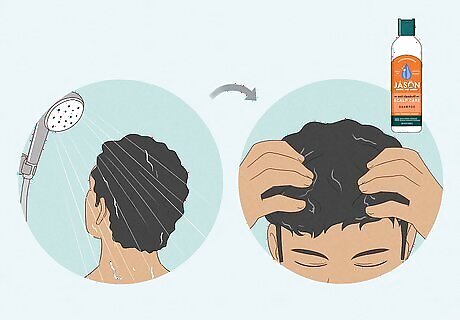
Shower and apply anti-dandruff shampoo. To apply the shampoo, wet your hair, then massage the dandruff shampoo into your scalp. Let it sit in your hair for five to 10 minutes before rinsing it out. Wash with your anti-dandruff shampoo every day until the flaking, itching, and inflammation are less severe. If you have curly, natural hair, daily shampooing might irritate your scalp more. Instead, use dandruff shampoo once a week. You can also ask a dermatologist about which shampoo would work best for your hair or ask them for a steroid preparation in oil that can be applied like pomade. If you notice no improvement after a few days of using anti-dandruff shampoo, try a shampoo with a different ingredient. Since dandruff is often caused by a species of yeast, an antifungal shampoo may attack the problem from a different direction. Some people report success when alternating between two shampoos, using each one every other hair-washing session.
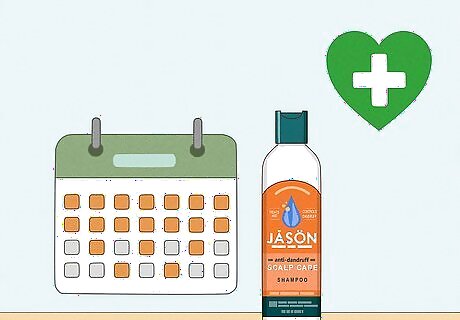
Reduce shampooing frequency as your condition improves. Once you notice a significant improvement, reduce anti-dandruff shampoo use to two to three times per week, or even less if you can keep your dandruff to an acceptable level. Once the severe flaking stops, there is typically no need to continue applying every day. If you are using prescription-strength shampoo or more than one type of treatment, reduce the frequency or stop use after two weeks to prevent harmful side effects from developing.
Controlling Dandruff Long-Term
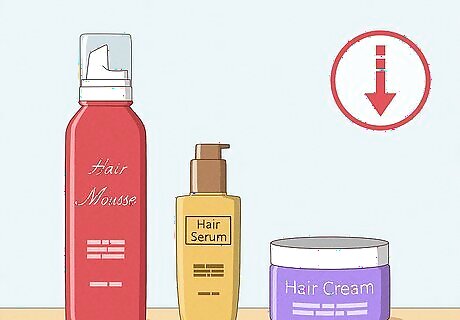
Reduce how many hair-styling products you use. If the dandruff flakes are thin, translucent, and found only on the hair (not the scalp), they’re likely a reaction to hair styling products. Look to see if your hair products contain Paraphenylenediamine, an ingredient that often causes dandruff issues. If you use multiple hair care products with different ingredients, this can also cause flaking. If you think hair care products may be causing your issue, eliminate or switch your styling products or wash your hair a little more frequently. If you aren't sure which product is specifically causing the issue, stop using one at a time until the problem stops.
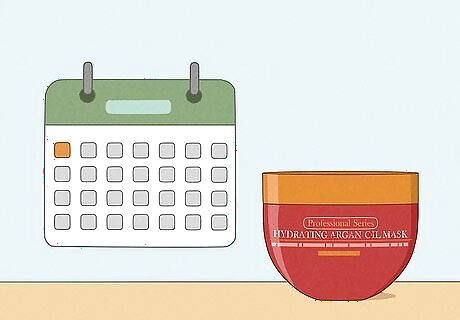
Use a deep-conditioning treatment once a month. Although dandruff isn’t caused by dry or oily scalps, a deep-conditioning treatment might help nourish the scalp and loosen up old flakes. Deep conditioning can also regulate any oil-regulating issues your scalp may have as a result of your dandruff. Here are hair mask deep-conditioning treatments you can use once a month to help control flaking: Arvazallia Hydrating Argan Oil Hair Mask Purenature Tea Tree Hair Mask Botanic Hearth Tea Tree Oil Hair Mask
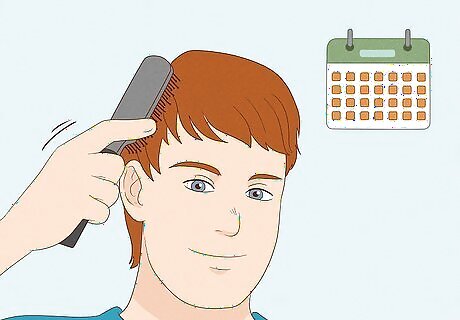
Brush your hair every day. Regularly brushing your hair can help evenly distribute oils and pick up pieces of skin or dirt from your hair. You can also exfoliate your scalp in the shower by brushing with a scalp brush or your fingers. Brushing in the shower can help stimulate the scalp and exfoliate cell buildup that causes flaking.

Expose your scalp to more sunlight. Exposing your scalp to moderate doses of sunlight may help reduce your dandruff. However, increased exposure to sunlight can be harmful to your skin, so try not to lay outside longer than an hour. Apply sunscreen before you go out and spend 30 minutes to an hour to allow your scalp to soak up the sun. Dandruff usually improves during the summer because of the increase in sunlight, unless the weather is unusually hot or humid.

Reduce your daily stress. Increased or unmanaged stress might trigger dandruff or worsen your flaking. To help with your dandruff, try to get the recommended amount of sleep, exercise regularly, and avoid excessive alcohol, tobacco, or substance use. You can also help calm your mind by practicing deep breathing exercises or meditating every day. Seeking out a support system of friends and family to talk about your feelings with can also help you release any emotional tension you might be holding.
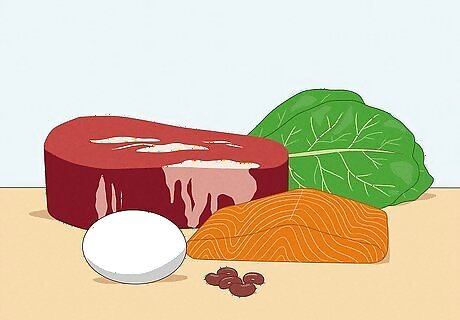
Eat a healthy diet full of zinc, B vitamins, and Omega fatty acids. Zinc, found in meat fish and seafood, and B vitamins, found in meat, eggs, legumes, and leafy greens, can support your immune system which can help fight off fungal infections that cause dandruff. Omega-3 fatty acids also help manage oil production and reduce inflammation, which may reduce dandruff. Eat foods that are rich in Omega-3 fatty acids like salmon, trout, chia seeds, flaxseeds, or nuts such as walnuts. You can also take probiotics to enhance your immune system function. Take a probiotic supplement, or eat fermented foods like kombucha, kimchi, or sauerkraut. Try to avoid or limit foods that harm your gut’s microbiome and immune system, like refined carbs (white bread, pasta, crackers), red meat, or processed, fried, or sugary foods/beverages.

Discuss treatment with your doctor. If you are not satisfied with the level of dandruff you have after a few weeks of self-treatment, consult a doctor. Dandruff rarely causes physical problems, but if you would like to get rid of it for personal reasons, a doctor may prescribe stronger medication. They may also recommend additional steroid treatment to reduce inflammation and itching as well. For severe cases, isotretinoin may be prescribed, but as this can have severe side effects, it is only recommended as a last resort.




















Comments
0 comment